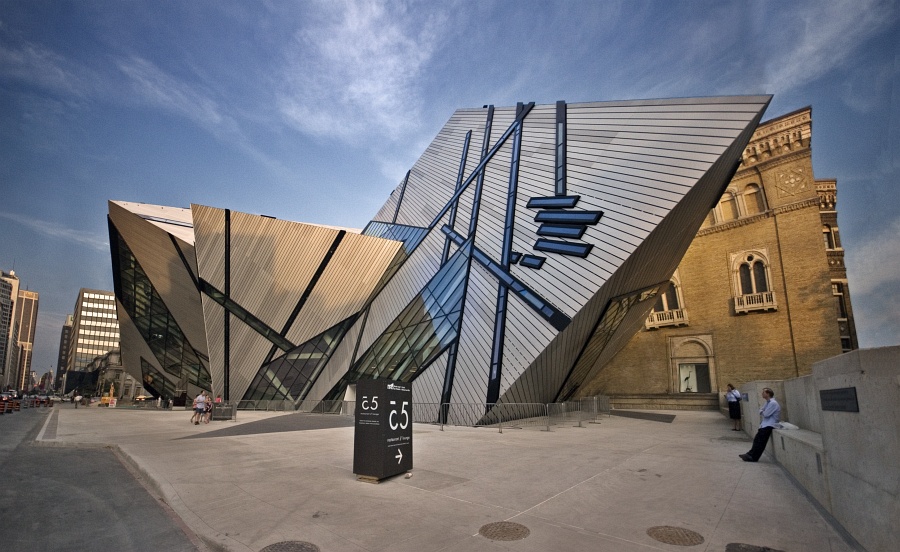

In an era pre-occupied by “starchitecture” and the dominance of global cities, New Yorker architecture critic Paul Goldberger makes a persuasive case for the importance of workaday structures and the limitations of urban planning.
“I don’t buy the notion that you can draw a clear line between great architecture and ordinary buildings,” he said Friday during the Canadian Urban Institute’s Designing Cities symposium. “Each structure has something to say about the culture that built it.”
Goldberger has just released a new book entitled, “Why Architecture Matters” (Yale), in which he sets out to mine the meaning of Winston Churchill’s famous aphorism, “We shape our buildings and thereafter they shape us.” 
 Architecture, observed the Roman builder and engineer Vitruvius, encompasses “commodity, firmness and delight,” and Goldberger, a Pulitzer Prize winner, cites this enduring definition to point out the paradox at the core of the most visible of all art forms. A building has to be “both useful and the opposite of useful,” he says. “It makes sense to think of architecture as both great masterpieces and daily experiences… Sometimes, it is the average [building] that tell us the most.”
The current recession, he said during an interview with me on Friday (the full conversation will be available on Spacing Radio on the December 7th episode), has dampened demand for good design. “In the very short term, we’re going to struggle to have architecture at all.”
Looking beyond the recovery, however, Goldberger feels the next wave of architecture will focus on the need for highly flexible design that recognizes the changing nature of family life. He also predicts that sustainable design “will become so taken for granted that we’ll stop talking about it.”
Goldberger further argues that bold experiments such as New York’s High Line, Broadway’s new “piazza” and the West Toronto RailPath mark a distinct trend in the way cities are thinking about the purpose of open space. “We’ve viewed public space as being about stasis — it’s where you sit and don’t move.”
With cities lacking both money and space to create new Central Parks, they are looking instead to linear parks as a means of re-claiming waterfronts or aging infrastructure. “Cities are about movement and circulation as much as anything else,” he observes. “We’re looking at places of movement as being public spaces.”
In New York, Toronto, and Ottawa, all these issues converge in brown-fields mega-projects — the Hudson and Atlantic Yards in New York, Lansdowne Live in Ottawa, or Toronto’s waterfront, the development of which is poised to get a big boost from the 2015 Pan Am Games.
Goldberger has written extensively about the problems facing the Atlantic Yards, a multi-billion-dollar mixed-use project focused on a new NBA stadium and destined for a 22-acre swath of Brooklyn’s waterfront. The project architect was Frank Gehry until this summer, when the developer, Bruce Ratner, fired him in favour of a less prominent commercial designer.
“These places present a real planning challenge,” he says. Such large swaths of urban land demand “some kind of large vision.” “Everything can’t be allowed just to happen.”
Goldberger points out that the re-development dynamic has almost reversed itself since Jane Jacobs fought Robert Moses’ expressway and housing schemes in Manhattan in the 1950s and 1960s. “If we leave our cities to grow naturally, they wouldn’t be places Jane Jacobs would have admired. We need to intervene.”
He warns, however, that there’s a risk of homogenization when vast sums of capital land with an “indifferent” thud in complex urban spaces, as is happening with the Atlantic Yards. “You can master plan,” Goldberger cautions, “but you need to allow incremental growth and planning guidelines that allow for variety.”
Still, the curious reality of our experience of built form is that even large and intrusive projects — he cites Stuyvesant Town in New York — will mellow with time. “Sometimes,” Goldberger muses, “the architecture doesn’t matter as much as we think it does.”
photo by Miles Storey




21 comments
Hmm… I have great fears that our great waterfront projects will end up much like the Atlantic Yards. Have we ever successfully developed large swaths of land in Toronto into a vibrant, mixed-use neighbourhood? Is that at all possible?
While I enjoy his columns and think very highly of his intelligence, Goldberger’s harsh criticisms lose some of their power when you consider that he has never worked as an architect, designer, developer or engineer. It’s all well and good to posit arguments for “this building should be this” or “this building should be that” but since his name or money has never been on the line I’m not sure he understands how difficult the birth of a building really is. It is not always possible to get everything right, but this can be hard to discern from the high horse of the critic’s post.
“Have we ever successfully developed large swaths of land in Toronto into a vibrant, mixed-use neighbourhood?”
Try the St Lawrence neighbourhood.
“Goldberger’s harsh criticisms lose some of their power when you consider that he has never worked as an architect, designer, developer or engineer.”
Nonsense! ‘Professionals’ are usually the last to see the destruction their profession’s group-think has wrought, because those most successful are those who rose through that system, are those who ‘drank the cool-aid’ most heartily. I see it daily in Education, and often enough in the other professions I am not a member of to be deeply cynical of the idea that you have to be fully invested in a system to be allowed to comment on it. History shows reform comes from without.
Anyone can make a critique. They deserve to be heard if they’ve educated themselves on the topic and made rational conclusions. It’s the same with music or film.
The reference to the St Lawrence neighbourhood is right on. It has it’s design failings i.e. some of it is pretty ugly, but as a model of where to start it’s the best we have. Remember seeing a doc. on development around similar European Courtyard concepts that encourage families but are still pretty high density. They are also inherently more eco friendly as they are much cheaper to heat and cool, don’t creat wind tunnels and don’t kill birds.
@Andrew “Have we ever successfully developed large swaths of land in Toronto into a vibrant, mixed-use neighbourhood? Is that at all possible?”
– Yes we have, it’s called the St Lawrence neighborhood
“Goldberger further argues that bold experiments such as New York’s High Line, Broadway’s new “piazza†and the West Toronto RailPath …”
Actually, this was build in 1995:
http://landscapeandurbanism.blogspot.com/2008/02/take-high-road-nyc-paris.html
And I think there is a confusion between “planning” and “urbanism” terms.
Yeah, I keep hearing about the success of St. Lawrence. Are there any good articles on it? (I know the area to walk around in, but I don’t really know what any of the residential is like)
In John Sewell’s book, “The Shape of the City: Toronto Struggles with Modern Planning,” there’s a fairly detailed account of how St. Lawrence was developed. It was an initiative of David Crombie’s reform council, and responded to growing calls in the 1970s for more residential development downtown — sounds strange today, with condos popping up all over the core, but at the time, people were moving away from the city centre. The area is a mix of market rentals and condos, as well as co-ops, affordable housing and senior’s housing. It has apartment buildings and townhouses, quite a lot of density despite the mid-rise heights, and comes with a full suite of amenities. While the buildings themselves are nothing to write home about, the area remains one of the most socially successful ventures in large-scale re-development within an urban setting. The area retains a strong mix of ages and income groupings.
Thanks John. I should pick up the Sewell book  I just finished his followup on the suburbs, which I thought was great.
Oh, another thing: the sainted Jane Jacobs was not educated as a planner, nor as an architect. And thank god for that!
As for St. Lawrence, it is livable, but has a fundamental flaw: the bourgeois leave once their children would go to the local schools with the kids in social housing, so the local schools continue to have a high rate of children living in poverty, and do not have bourgeois parents with kids in the system with the pull to make those schools work. Vicious cycle with no solution since the amount of subsidized housing is too high and thus the percentage of children in poverty is well over the 20% national average (which is bad enough). If we cared (we don’t) we’d put social housing in all neighbourhoods (boo hoo Rosedale) to average out the percentages.
If course, jamesmallon, that might just end up speeding the withdrawal of this city’s moneyed classes from public education.
Don Mills seems to work well. There’s a mix of housing types and employment.
Before the education string above gets out of hand, I’d point out that over 90% of school age children in Toronto attend public school, and that number has been rock solid for years, through boom times and recession alike.
The tolerance of fundraising as part of the core public school funding model is integral to school performance by demographic. The Star ran a piece last year showing how schools in more prosperous areas raised vastly more money than poorer neighbourhoods – helped by the fact that moneyed parents can write that off against taxes whereas poorer parents don’t receive a rebate unless they make enough money to pay the equivalent amount of income tax.
Unless the richer schools are “taxed” or fundraising simply forbidden with a consequent improvement in the funding formula (funded by an Ontario equivalent of this), these inequalities are doomed to continue.
As a middle-class parent who has done a lot of fundraising for a school that serves a very wide range of families in the Dufferin/Davenport area, I would never advocate a ban on fundraising because it sends the wrong sort of message to parents of all classes. Yes, fundraising can be highly problematic, and the schools — especially principals — have to be vigilant about what is purchased with said money. The board has policies, but they don’t always get enforced.
At the same time, fundraising can produce positive social benefits, because fundraising events like spring fairs and so on serve to draw communities together, and that’s not something I’d turn my nose up at — not in affluent neighbourhoods, nor in disadvantaged ones, nor any in between.
As for tax write-offs — I’m sure it happens, but I’ve never seen tax receipts issued.
Fair enough John – that said the TDSB policy does allow for it:
http://www.tdsb.on.ca/wwwdocuments/parents/fundraising_guide/docs/fundraisingprocedures.pdf
The Board is a registered charity and as such is pleased to issue receipts, hold funds in trust and satisfy the legislative and audit requirements issued. The principal must advise donors that cash or cheque donations of $25.00 or more to a school or program of the Board are eligible for a charitable donation receipt.
Andrew: I think the St. Lawrence Neighbourhood would be the closest example, but I can certainly find holes in it.
I am an elementary teacher, btw (so this is not my real name). I am fully against fundraising:
– it compounds school inequality
– it hides provincial funding shortfalls, that the public should be aware of
– the purse-strings are not in the hands of the classroom teachers, so the funds get spent on items on the agenda of the pushiest PTA parents
The only exceptions I can think of is fundraising for charities, with some caveats: Catholic schools fundraise for ‘Share Life’, which has a political agenda you can guess. Political fundraising, in the broadest sense, should be illegal in schools.
Andrew’s comment is disturbing in so many ways… In any case, I’d love to see (and never will) social housing integrated into all neighbourhoods in the country, not just the city. That would address even the Andrews of the city.
There are enough research and build examples of mixity around the world. Also, looking further than 20 km around would speed up the thinking process and maybe working on “city-building” mindframe, would make things more cost effective on long term, than going on “how-much-will-cost-me” mindframe.